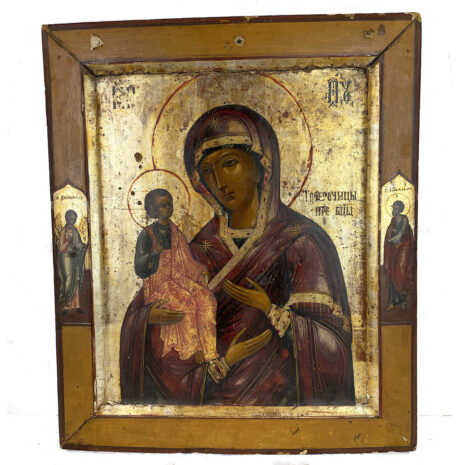Antique Icon of “Virgin Mary of The Three Hands” Holding the Infant Christ, Russia (0002BCEM)
$2,350.00
H: 17.5″ W: 14.875″ D: 1.75″ | FOR SHIPPING INFORMATION CONTACT US AT 213-568-3030
This vibrant antique icon of Virgin Mary of the The Three Hands is a traditional Eastern Orthodox image of the Mother of God with the infant Christ seated on her right arm and one underneath supporting him and her left raised and pointing to him. Her three hands confirm her special healing powers based on the legend of Saint John of Damascus. She is bordered on each side of the frame by saints. Russian icons are regarded as the Gospel in paint and are typically small paintings on wood panels using tempera and often ornate gold leaf. Panel cross members or “back slats” were used in pre-1890 Russian icons like this one.
Description
Other than Jesus, no other figure has been depicted more than Mary (Theotokos in Greek) in Eastern Orthodox imagery. The three handed Madonna originated in the 8th century when icon worship was debated in Eastern and Orthodox churches. In 726 Byzantine Emperor Leo III prohibited religious icon images to be worshiped. He reported to the Caliph of Damascus that monk John of Damascus was treasonous in supporting icon veneration and the Caliph had John’s right hand cut off. After John prayed to a Mother of God icon, his hand was miraculously restored. In gratitude, John (later proclaimed a Saint) painted a three handed Madonna with a silver-colored third hand declaring “Your holy hand healed the cut off one of mine, and it will destroy all your enemies and all of these who trample the holy images of You and Your Mother. These who defile the icons will be crushed in Your honor.” (St Elizabeth Convent). In the 17th century, Nikon, patriarch of the Russian Orthodox in an effort to make Moscow the center of Eastern Orthodoxy imported relics of Christianity including the three handed Madonna from the Iveron Greek Monastery and distributed copies to Russian royalty and monasteries. In 1718 icon-painters Artemiy Fedorov and Afanasiy Ivanov painted a famous three-handed Madonna with the third hand realistically emerging from her garment, which became a prototype in many 18-19th century icons. The three-handed Madonna remains one of the most revered Russia icon prototypes. An Eastern Orthodox church hymn was dedicated to honor her and commemorative feast days were selected for celebration on July 12 in Slavic countries. She wears a shroud to demonstrate humility and piety and a left hand points to the Infant Jesus she cradles in her right arm and supports him with her third hand. The third hand symbolism expanded since first introduced by St. John. Živojin writes that it reflects Mary’s universal understanding of her Son saying, “You are my other [third] hand.” The three hands also symbolize the Trinity and an Eastern Orthodox Church hymn states “the Mother of God takes the Son with two hands, but the third one symbolizes protection for all praying people.” (St. Elizabeth Convent). In the 17th century, Christ in Mary’s lap was first depicted with his index, middle and thumb fingers raised together, the same gesture priests use to bless congregations. The left side of the panel depicts Archangel Gabriel representing the coming of Christ. This icon is in very good condition with expected signs of aging gilt, chips, cracks and paint losses and is part of the VA Collection of Christian-Art
Sources
Andrejić Živojin R., “Interpretation of the icon of Three-Handed Virgin Mary of the St. Trinity church in Karan,” Ingenta connect
Convent of St. Elizabeth, “How the ‘Three Hands’ Icon Came to Be,” posted July 25, 2017.
Icon.it, “Icon of Mother of God ‘The Three-Handed’”
Iconreader, “A Readers Guide to Orthodox Icons: Icons of the Mother of God,” posted July 7,2010.
Additional information
| Place of Origin | Russia |
|---|---|
| Period | Antique (1200-1920) |
| Date | 18-19th Century |
| Materials and Technique | Wood |
| Dimensions (inches) | Ht: 17.5”. W: 14.875” Depth: 1.75” |
| Dimensions (metric) | Ht: 44.45cm. W: 37.78cm. Depth: 4.44cm |
| Condition | Very good, see description |
| Item Number | 0002BCEM |
| Shipping Box Size | Oversized. Call 213-568-3030 or email [email protected] for shipping. |














